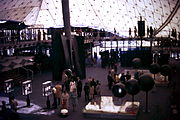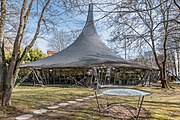User:Kawaguchi K./sandbox
Yasuhiko Hangai | |
|---|---|
| Born | Yasuhiko Hangai 25 April 1942 Sukagawa, Japan |
| Died | 9 August 1998 (aged 56) Toranomon Hospital, Tokyo, Japan |
| Nationality | Japanese |
| Alma mater | University of Tokyo |
| Awards | AIJ Prize (1989), Pioneers' Award (1993) |
Yasuhiko Hangai ( 25 April 1942 – 9 August 1998) was a Japanese researcher of structural engineering and a professor at the
Biography
- April 1942, Born in Fukushima prefecture, Japan
- March 1965, Graduated from Department of Architecture, University of Tokyo
- June 1969, Promoted to Research Associate at the Institute of Industrial Science (IIS), University of Tokyo during graduate course, Department of Architecture, University of Tokyo
- March 1973, Received Doctor of Engineering from University of Tokyo
- April 1975, Promoted to Associate Professor, IIS
- August 1979-July 1980, Appointed Visiting Associate Professor, University of Waterloo, Canada
- April 1985, Promoted to Professor, IIS
- June 1989, Architectural Institute of Japan (AIJ) Prize for Research Paper “Fundamental Studies of Structural Instability Theory and its Applications to Spatial Structures”
- 1988 Promoted to a member of Executive Council, IASS(continued to his death)
- September 1993 Received Pioneers’ Award from University of Surrey, UK
- 9 August 1998 Died at age of 56
Early life
Yasuhiko Hangai was born on 25 April in 1942 as the second of five children, all sons, of Katsumi (father) and Ai (mother) Hangai. His father Katsumi served as a junior-high school teacher in
Career
He began a private practice in Germany in 1952. His saddle-shaped cable-net music pavilion at the Bundesgartenschau (Federal Garden Exposition) in Kassel brought him his first significant attention. He earned a doctorate in tensioned constructions in 1954.[1]
Otto specialised in lightweight
Until his death, Otto remained active as an architect and engineer, and as consultant to his protégé Mahmoud Bodo Rasch for a number of projects in the Middle East. One of his more recent projects was his work with Shigeru Ban on the Japanese Pavilion at Expo 2000 with a roof structure made entirely of paper, and together with SL Rasch GmbH Special and Lightweight Structures he designed a convertible roof for the Venezuelan Pavilion.[2] In an effort to memorialise the September 11 attacks and its victims as early as 2002, Otto envisioned the two footprints of the World Trade Center buildings covered with water and surrounded by trees; his plan includes a world map embedded in the park with countries at war marked with lights and a continuously updated board announcing the number of people killed in war from 11 September 2001, onward.[3]
On request of de:Christoph Ingenhoven, Otto designed the "Light eyes" for Stuttgart 21.[4] – drop-shaped overlights in the park, that descend onto the tracks to support the ceiling.[5][6] Otto remarked in 2010 that the construction should be stopped because of the difficult geology.[7][8]
Otto died on 9 March 2015; he was to be publicly announced as the winner of the 2015
Career
After graduation from the high school then he entered the University of Tokyo (Natural Science I). He majored in Architecture and joined the Umemura lab at Hongo campus for his graduation thesis and the Tsuboi lab at Institute of Industrial Science for the graduate course.
As part of his master thesis, Hangai helped with numerical calculations of a double-layer space frame roof constructed at Uchinoura Space Center to house epsilon rockets [11]. He continued his doctoral studies in the same lab and in the second year,1969, he was offered to be a research associate when Professor Yoshikatsu Tsuboi retired, and the lab was taken over by Shigeya Kawamata as the associate professor. In the same year, Hangai married Naoko Kojima, who was a research officer of chemistry in the same institute. He obtained a doctorate degree of engineering from the University of Tokyo with his thesis “Analysis of Geometrically Nonlinear and Stability Problems by Static Perturbation Method” on 22 March 1973.
In 1975, when Professor Kawamata moved to the
Lifestyle and passing
Hangai arrived at the lab at 8:30 am every morning, finished lunch in 15 minutes, and intensively enjoyed playing “Go” or “Shogi” (Japanese chess) with colleagues in neighboring labs. In the evening, he finished his work at 5:15 pm and never worked overtime. After work, he enjoyed playing Go, Shogi or chatting with friends or students. Hangai had a variety of hobbies, such as mountain climbing, playing Go and Shogi, skiing, playing tennis,
Works
Hangai’s works specialized in non-linear behavior and its numerical analysis of thin curved structures, such as shells, space frames and membrane structures. These are often classified as “spatial structures”. He was a leading pioneer in instability problems of thin shells and space frames in Japan. He also initiated the applications of generalized inverse to structural analysis with Professor Hisashi Tanaka, which was very early even at a global level. Afterwards, he was one of the researchers who started so-called “computational morphogenesis”, which eventually became a big new trend in the field of structural and architectural design. In addition to serving as a professor at the University of Tokyo (Institute of Industrial Science), Hangai also played a very important role in and made essential contributions to establish the Japan Society of Computational Engineering and Science (JSCES) with Professor Tadahiko Kawai. In a research group of computational engineering and science, the predecessor association of JSCES, he led the special research group for non-linear problems, in which he mentored and fostered many young researchers.
In 1984, Hangai started Japan-Korea summer colloquium on shell and spatial structures with prof. Teak-jin Kwun, which has gradually grown as Asian Pacific Conference on Shell and Spatial Structures, which involves other Asian countries, Australia and west coast of USA.
Hangai Prize

After sudden death of Yasuhiko Hangai, his widow, Mrs. Naoko Hangai, placed a donation under care of a group of his former students to be used for the development of research of spatial structures. They used the donation to establish a prize for young talented people, “Hangai Prize”, in the IASS based. It has been awarded to four young researchers, engineers or architects every year since 2003. The medal given to the awardee was designed by Professor Katsumi Nagase (Hosei University) and Mrs. Hangai.
List of buildings
This is a partial list of buildings designed by Otto:[10]
- 1967 – West Germany Pavilion at Expo 67 Montreal
- 1972 – Roof for Olympic Stadium, Munich
- 1975 – Multihalle, Mannheim
- 1977 – Umbrellas for 1977 Pink Floyd tour
- 1980 – Aviary at Munich Zoo
- 1985 – Tuwaiq Palace, Saudi Arabia, with Buro Happold
- 2000 – Roof structure of the Japanese Pavilion at Expo 2000, Hanover Germany (provided engineering assistance with Buro Happold and architectural collaboration with Shigeru Ban)
-
Interior view, West Germany Pavilion, Expo 67, Montreal, Canada
-
Multihalle in Mannheim
-
Institut für Leichte Flächentragwerke, University of Stuttgart
Awards (selected)
- 1974 – Thomas Jefferson Medal in Architecture[13]
- 1980 – Honorary doctorate of science from the University of Bath[14]
- 1996/97 – Wolf Prize in Architecture[14]
- 2005 – RIBA[15]
- 2006 – Praemium Imperiale in Architecture[2]
- 2015 – Pritzker Architecture Prize[9][10]
See also
References
- ^ a b c Cite error: The named reference
biowas invoked but never defined (see the help page). - ^ a b c "Frei Otto". Praemium Imperiale. Archived from the original on 24 September 2015. Retrieved 11 March 2015.
- Wall Street Journal.
- ^ "Meilenstein in Stuttgart: Erster Musterkelch wurde betoniert". ingenhoven architects. 18 March 2016.
- ^ Werner Sobek: S21 Tiefbahnhof Stuttgart.
- ^ Video: Animation. Stuttgart 21 – Ein Bahnhof kommt unter die Erde. and pictures: Großprojekt Stuttgart 21: Wie der Bahnhof einmal aussehen soll.
- ^ Hans Monath, Andreas Böhme: Bahn soll bei Stuttgart 21 Notbremse ziehen.
- ^ Stuttgart 21-Architekt fordert den sofortigen Baustopp.
- ^ a b "Frei Otto, 2015 Laureate". Pritzker Architecture Prize. 10 March 2015. Retrieved 11 March 2015.
- ^ a b c d Pritzker Prize for Frei Otto, German Architect, Announced After His Death, Robin Pogrebin, The New York Times, 10 March 2015
- ^ [1]
- ^ Kenchiku-Zasshi, AIJ, Vol.113, No.1428, 1998
- ISBN 978-0-9755654-2-1.
- ^ ISBN 978-0-7277-2877-7.
- ^ The man with the golden pen, Building.co.uk, 2005 issue 08
Further reading
- Conrad Roland: Frei Otto – Spannweiten. Ideen und Versuche zum Leichtbau. Ein Werkstattbericht von Conrad Roland. Ullstein, Berlin, Frankfurt/Main und Wien 1965.
- Frei Otto, Bodo Rasch: Finding Form: Towards an Architecture of the Minimal, 1996, ISBN 3-930698-66-8
- Philip Drew, "Frei Otto; Form and Structure", 1976, ISBN 978-0-258-97053-9
- Philip Drew, "Tensile Architecture", 1979, ISBN 978-0-258-97012-6
External links
- Kawaguchi K./sandbox at archINFORM
- Frei Otto's official website
- Frei Otto: Spanning The Future Documentary film's official Website
- Japan Pavilion Expo 2000 – About the roof structure
- SL Rasch GmbH Homepage
- Last recorded interview with Frei Otto, about his life and receiving the Pritzker Prize
- Uncube Nr. 33 Frei Otto – by uncube magazine




